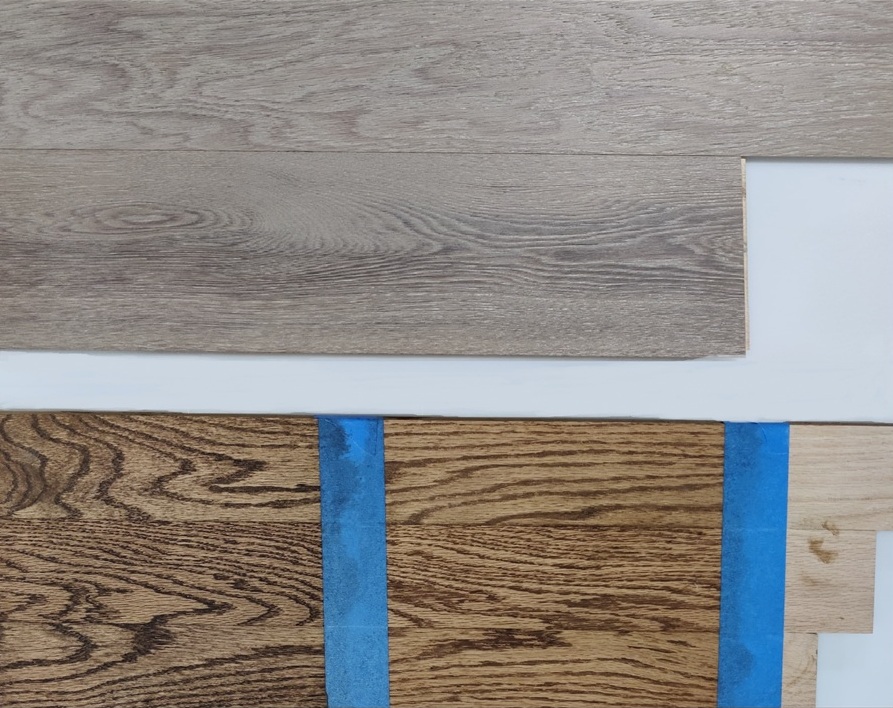Introduction
If you're planning a hardwood flooring project, you'll face an important choice: prefinished hardwood, also called factory-finished (top) or unfinished, also called site-finished (bottom). Each option offers distinct advantages in looks, installation process, durability, and long-term care. No matter which type you choose, both prefinished and unfinished hardwood must be acclimated to your home's temperature and humidity for several days before installation to prevent future warping or gaps. In this article, we explain the differences between unfinished and prefinished hardwood, outline the pros and cons of each, and help you decide which is best for your home or business.
What Is Prefinished Hardwood?
Prefinished hardwood comes with stain and protective finish applied at the factory, so each board is ready to install right out of the box. These finishes are cured under controlled conditions, often using UV light, to create a highly durable and scratch-resistant surface that is difficult to achieve with on-site finishing. Prefinished hardwood is available in both solid and engineered forms, each offering distinct advantages in different settings. For a detailed comparison of solid versus engineered prefinished flooring, read our guide on Engineered vs Solid Prefinished. Prefinished boards almost always feature micro-beveled edges, which help hide slight height differences between planks and give each board a distinct outline. A bevel is a small, angled edge cut along the sides of each board, creating a subtle groove where boards meet. This makes installation faster and reduces the appearance of minor subfloor imperfections.
Advantages:
- Faster, cleaner installation with less disruption to your home
- Factory-applied finish is extremely tough and consistent
- Can walk on the floor immediately after installation
- Limited customization: what you see is what you get
- Micro-beveled edges are visible between planks
- Difficult to seamlessly match new boards to older prefinished flooring
What Is Unfinished Hardwood?
Unfinished hardwood flooring is delivered as raw wood planks that are installed and then sanded, stained, and finished on-site in your home. This approach offers full customization for color, sheen, and even surface texture.
Advantages:
- Custom stain color and finish options to perfectly match your design
- Smooth, seamless surface without bevels between boards
- Ideal for large or intricate spaces that need blending
- Installation is longer and messier (sanding, staining, finishing done on site)
- Must vacate the area for several days to allow for drying and curing
- Higher risk of dust or fumes during installation
When to Choose Prefinished Hardwood
Prefinished hardwood is the right choice if you need a fast, low-mess installation or want maximum durability with minimal downtime. It's great for busy households, condos, or when you need to move in quickly after a remodel.
When to Choose Unfinished Hardwood
Unfinished hardwood is ideal for projects where you want a custom look, have unique color requirements, or need to blend new floors with existing wood. It's the top choice for restoration in historic homes or when you want a flush, uniform surface throughout a large space.
Common Myths
- Unfinished hardwood is always higher quality: Both unfinished and prefinished can be made from the same top-grade wood species.
- Prefinished floors can't be refinished: They can, though sanding micro-beveled edges may require more skill.
- Unfinished floors are weaker: Site-applied finishes can be very durable but may require more upkeep than factory-applied coatings.
What to Expect in Terms of Price
Material costs are often similar, but installation costs and timelines differ. Unfinished hardwood is more labor-intensive to install and finish, which can mean higher installation costs and more time before the space is usable. After installation, the finish needs time to dry and cure, you should avoid dragging heavy objects or furniture for about 14 days to prevent scratches or damage while the floor fully hardens. Prefinished hardwood typically lowers labor costs and can be completed faster, saving on both installation expenses and lost time. Always get a detailed estimate that covers both product and installation for an accurate comparison.
Final Thoughts
There's no single right answer; unfinished and prefinished hardwood each have strengths. Unfinished offers customization and seamless results, while prefinished delivers speed, convenience, and durability. Consider your timeline, budget, design preferences, and lifestyle to choose what's best for your home. If you're unsure, consult with a flooring professional or visit a showroom to see and feel both options in person.
